The pharmaceutical industry is growing day by day, and the COVID pandemic has just accelerated its online direction of development. According to the latest data, in the long term the global online pharmacy market size is expected to grow up to USD 336.7 billion by 2030.
What is an e-pharmacy?
An e-pharmacy, also known as an online pharmacy or digital pharmacy, is a virtual platform where customers can browse, purchase, and receive pharmaceutical products and healthcare items online, playing an increasingly significant role in the pharmaceutical industry..
Unlike traditional pharmacies, e-pharmacies operate solely through digital platforms, eliminating the need for physical storefronts. At the same time, online pharmacies can be part of an omnichannel business. This means you can place an order online and pick it up at a physical pharmacy. These online medical stores provide an extensive catalog of prescription medications, over-the-counter drugs, vitamins, supplements, and personal care products, offering customers various options to address their health needs. By leveraging technology and digital tools, pharmacy marketplaces streamline the ordering process, allowing users to upload prescriptions, select desired products, and easily buy medications online.
Additionally, many online pharmacy stores offer convenient features such as automated refill reminders, medication management tools, and virtual consultations with healthcare professionals, enhancing the overall customer experience and promoting better medication adherence. Overall, e-pharmacy shops provide a modern and accessible solution for individuals seeking convenient access to healthcare products and services from the comfort of their homes.
How eCommerce Pharmacy works
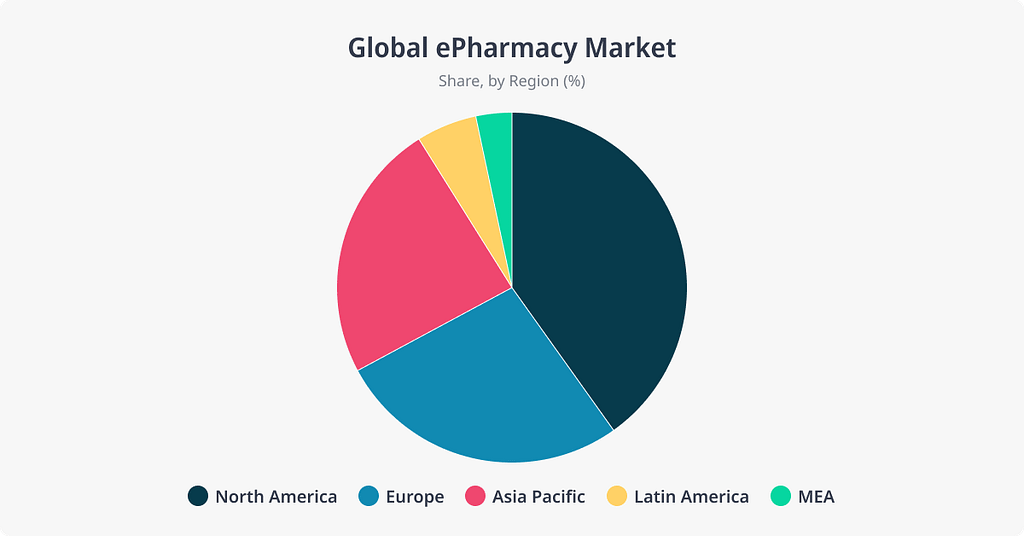
ePharmacy global market analysis report by Grand View Research, 2024
In essence, the operation of a pharmacy eCommerce revolves around the seamless integration of technology and healthcare services to facilitate the online purchase and delivery of pharmaceutical products.
The process typically begins with creating a user-friendly website or mobile app that serves as the digital pharma marketplace in the epharmacy market, a growing segment of the pharmaceutical industry. Customers can access the platform, browse the available products, and add items to their virtual shopping carts. Online pharmacies play a crucial role in this ecosystem, offering a convenient way for customers to obtain their medications. Upon checkout, users are prompted to provide necessary information, such as their shipping address and payment details. Once the transaction is completed, the pharmacy’s backend system processes the order, verifies the prescription if applicable, and prepares the products for shipping.
In some cases, e-pharmacies may partner with third-party logistics providers for efficient order fulfillment and timely delivery to customers’ doorsteps. Throughout the process, robust security measures are implemented to safeguard sensitive data and ensure compliance with healthcare regulations, guaranteeing all users a safe and secure online shopping experience.
Benefits of starting an online pharmacy business
Starting a pharmacy business offers many benefits for entrepreneurs looking to enter the medical e-business. Let’s break down the most crucial ones:
- Reach a broader customer base: Digital pharmacies can extend their reach to customers in various regions or countries. Unlike traditional brick-and-mortar pharmacies, an e-pharmacy can cater to customers regardless of their location, allowing for a wider audience and potential market expansion.
- Convenience and accessibility to customers: With an eCommerce platform, online pharmacy shops can operate round the clock, offering customers the flexibility to browse, refill, and sell pharmaceuticals online at any time of the day or night. This convenience is especially beneficial for individuals with busy schedules, requiring urgent medication, or in different time zones.
- Streamline operations and reduce overhead costs: E-pharmacies often benefit from streamlined operational processes and reduced overhead costs compared to their traditional counterparts. Automating tasks such as inventory management, order processing, and payment transactions can increase efficiency and cost savings.
- Optimize inventory management processes: E-pharmacies can leverage sophisticated inventory management systems to monitor stock levels, track expiration dates, and streamline procurement processes. Real-time inventory updates help prevent stockouts, minimize wastage, and ensure that essential medications are always available to customers.
- Leverage data analytics and customer insights for personalized marketing: Digital pharmacies can collect valuable customer preferences, purchasing behavior, and medication history data. By analyzing this data, pharmacies can tailor marketing campaigns, recommend personalized products, and provide targeted promotions to enhance customer loyalty.
- Enhance customer engagement and service quality: Through features such as live chat support, online consultations, and informative content, e-pharmacies can offer enhanced customer service experiences. Prompt responses to inquiries, professional advice from healthcare experts, and educational resources contribute to customer satisfaction and trust in your online pharmacy business. However, it’s crucial to address safety concerns with medications like Ozempic, which has been associated with serious adverse effects when misused. Ensuring that your online pharmacy provides proper guidance and warnings about such medications can help mitigate potential risks to customers.
The components of a successful Pharmacy eCommerce Website
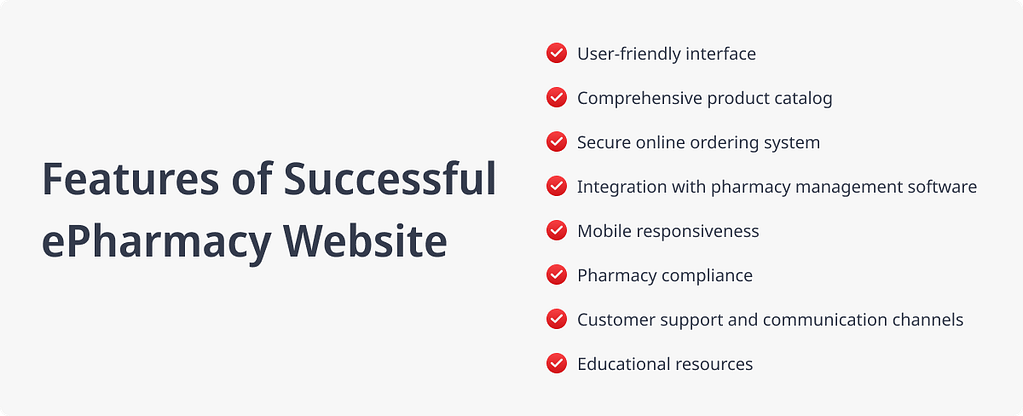
A successful pharmacy eCommerce website comprises several key components contributing to its effectiveness and user experience. Here are the most important ones to follow if you are opening your own pharmacy:
User-friendly interface
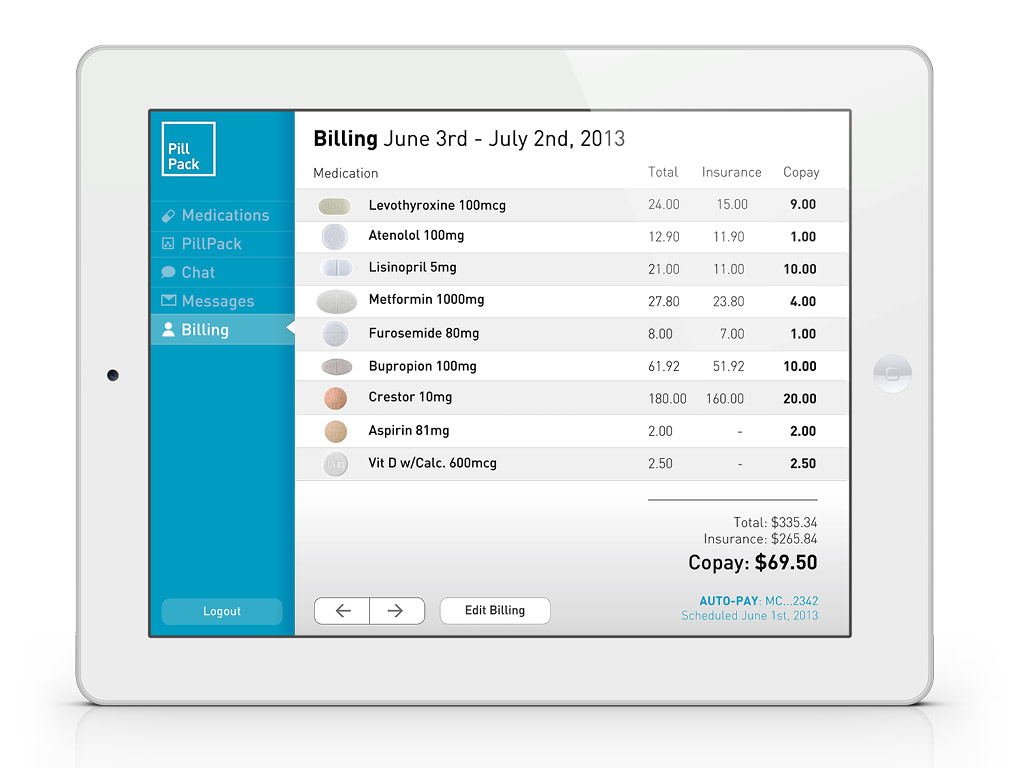
An intuitive and easy-to-navigate website interface is essential for providing customers with a seamless browsing and shopping experience. Clear categorization of products, simple navigation menus, and a visually appealing layout contribute to a positive user experience.
Comprehensive product catalog
Maximize the assortment in the online pharmacy. The customer wants to buy all the necessary medicines in one place. You just pass a potential client to your competitor if something is missing.
Each product listing should include detailed descriptions, dosage information, pricing, and availability status. Additionally, it should demonstrate blocks with product analogues to allow customers to compare them on the page.
Also, don’t forget about notifications about purchasing incompatible medicines and other features that will help the site visitor feel taken care of.
Secure online ordering system
A robust and secure online ordering system is crucial for facilitating safe and convenient transactions. The website should implement industry-standard security measures such as SSL encryption to protect sensitive customer information during checkout.
Integration with pharmacy management software
Think of integrating a CRM system with the ability to create a personal account for each user. This will allow not only tracking demand and regulating advertising and purchases in this regard but also making timely individual offers to the client: for example, reminding them of running out of medicines that must be taken regularly.
This type of integrations enable seamless synchronization of inventory, orders, and customer data between the eCommerce platform and the backend pharmacy operations. This integration streamlines business processes, minimizes errors, and ensures accurate order fulfillment. Good examples are services such as drugs.com or CVS.
Mobile responsiveness
With the increasing use of mobile devices for online shopping, a pharmacy eCommerce website needs to be fully responsive across various screen sizes and devices. The mobile-friendly design ensures that customers can easily access the website and make purchases from smartphones and tablets.
Pharmacy compliance
Adherence to regulatory requirements and industry standards is paramount for operating a pharmacy eCommerce website. This includes compliance with laws and regulations governing the sale of pharmaceuticals online and adherence to data privacy and security standards.
For example, the FDA doesn’t approve Domperidone for use in the USA due to concerns about its potential cardiac side effects. Therefore, the medicine is prohibited for sale. The same applies to Phenacetin, a pain reliever, and fever reducer that was once widely used but has been banned in many European countries due to its association with kidney damage and cancer.
Customer support and communication channels
The website should provide multiple channels for customer support and communication, such as live chat, email, and phone support. Prompt and responsive customer service helps address customer inquiries, resolve issues, and build customer trust and loyalty.
Educational resources
Providing informative content and educational resources on health topics, medication usage for complicated therapies like medical massage therapy or acupuncture programs, and wellness tips enhances the website’s value proposition. Articles, blog posts, and FAQs can help educate customers and establish the pharmacy as a trusted source of health information.
Online and mail-order pharmacy license requirements
Obtaining the necessary licenses and permits is vital for operating an online or mail-order pharmacy legally and responsibly, especially when these pharmacies also serve consumers transitioning from a physical store. The specific requirements vary depending on the jurisdiction and the type of pharmacy services offered. Generally, businesses must acquire pharmacy licenses from the relevant regulatory authorities, demonstrating compliance with local laws and regulations governing pharmaceutical sales. This often involves fulfilling stringent criteria related to facility standards, like proper storage facilities for medications, including temperature-controlled areas for storing refrigerated medications and controlled substances.
Besides, the pharmacy marketplace must check pharmacist qualifications and maintain record-keeping practices and patient confidentiality protocols. Additionally, businesses may need permits for specific activities, such as controlled substance dispensing or international shipping. The medications that are most often prohibited from sale through online pharmacies typically include:
- Controlled substances. due to their potential for abuse and misuse. Examples include opioid painkillers, stimulants, and certain sedatives.
- Prescription medications. Online pharmacies may be prohibited from selling prescription drugs without a prescription to ensure proper oversight and patient safety.
- Potentially dangerous drugs. Medications with a high risk of adverse effects or complications, especially when used improperly, may be restricted from online sale. This includes drugs with a narrow therapeutic index, high potential for drug interactions, or significant side effects.
- Counterfeit or illegally manufactured drugs. These drugs pose significant risks to patient safety and may not meet quality standards.
- Over-the-Counter (OTC) medications. Some countries may restrict pharmaceutical companies from selling certain over-the-counter medications through online pharmacies, particularly if they are subject to abuse or misuse.
- Medications requiring special handling. Drugs that require special storage conditions, such as refrigeration or protection from light, or those containing sensitive active ingredients, may be restricted from online sale due to concerns about maintaining their integrity during shipping and home delivery.
How much money can you make with a digital pharmacy?
The past four years were very successful for selling medications, and pharma revenues were 1.27 trillion USD in 2020 and are expected to reach 1.77 trillion USD by 2026, as reported by Statista.
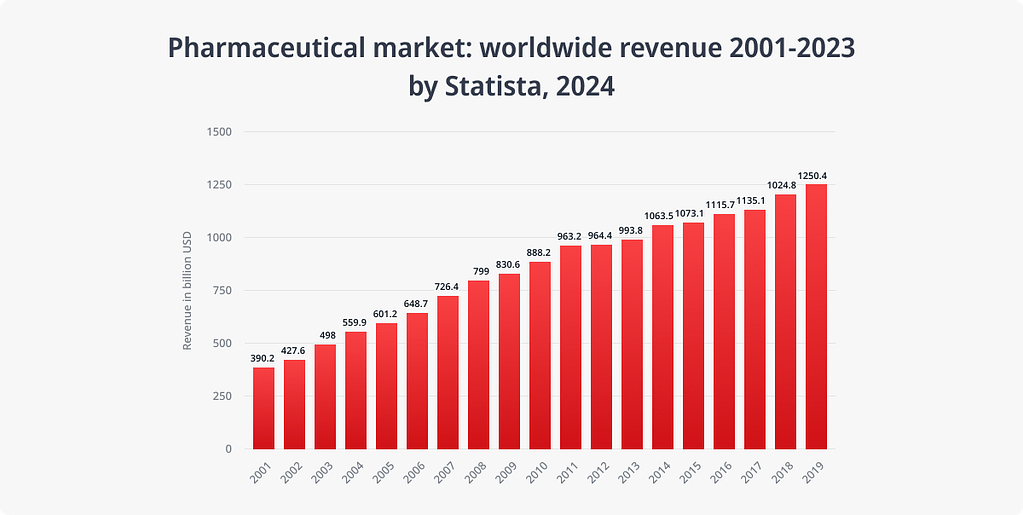
Pharmaceutical market: worldwide revenue 2001-2023 by Statista, 2024
The revenue potential of a digital pharmacy varies depending on a row of factors, including the business model, market demand, competitive landscape, and operational efficiency. Conducting thorough market research is crucial to understand these dynamics and identify opportunities for growth. A successful pharmacy start up can generate significant income streams through multiple channels, such as prescription medication sales, over-the-counter products, health supplements, specialized medications, and medical devices. These revenue streams are further enhanced by the integration of ecommerce websites, which expand customer reach and streamline online transactions, allowing pharmacies to tap into broader markets effectively.
Additionally, value-added services like telemedicine consultations, medication management programs, and subscription-based models can contribute to revenue growth. However, it’s essential to consider associated costs, including inventory management, regulatory compliance, marketing expenses, and technology investments such as emergency dispatch software. While some digital pharmacies achieve substantial profitability, others may face challenges due to intense competition, pricing pressures, regulatory constraints, or limited market penetration.
The accelerated growth of the pharma business can be attributed to the eCommerce site’s greater involvement. Let’s have a look at data from SimilarWeb — a digital market intelligence platform that provides insights and data analytics for websites and mobile apps, provides the following list of top pharmacy websites that were engaged the most.

We’ve collected the best experience and ideas accumulated by pharmacy eCommerce platforms to share number one online practices with you. Below is a step-by-step guide to launch an online pharmacy store.
How to start a pharmacy business? Tips to open pharmacy marketplace
You can sell over-the-counter drugs remotely, and in some cases, prescription drugs. If you’re wondering how to start an online pharmacy, it’s important to note that the online sale of narcotic and psychotropic drugs, and alcohol-containing drugs is still prohibited.
Step 1: Decide on what to sell
Online sale of prescription drugs
Selling prescription drugs online is challenged by the following fears that need to be resolved first:
- State regulation compliance
- Creating trust with online customers
- Validation of medicines offered for a purchase
- E-prescription acceptance functionality
The first two concerns can be resolved with the proper accreditation. NABP, the National Association of Boards of Pharmacy, can confirm whether online drugs comply with national pharmacy standards. Having the NABP badge in your marketplace will make consumers feel more secure against counterfeit pills.
Here, a subscription pharmacy business model may help. It means that customers won’t place regular orders; instead, your team gets the requests from patients and selects the required medicine. To implement this on a standard medicine eCommerce website platform, you need to remove the standard product catalog. The user journey will change: once registered, they submit the payment credentials and medical records (for instance, insurance number or physician details). As an online store owner, you need to control any reuse of the original prescription. You can integrate the e-prescription software to process the required documents directly from doctors.
PillPack is the USA online shop that uses this approach. You can take it as an example. In fact, you don’t have to sell drugs, you can sell optics, as long as you comply with all legal regulations
Online sale of over-the-counter drugs
Selling over-the-counter drugs is easier for online stores and marketplaces and you can launch your business on a standard eCommerce platform for effective product catalog management, promos, quick checkout, payment and order processing. There is no strict control over prescription legitimacy. However, some precautions must be taken to ensure your online pharmacy is legal and to avoid bad customer experience:
- Give a comprehensive description of a medicine you sell: indications and precautions, usage directions, and possible side effects.
- Restrict the amount of medicine purchased per order.
- Quick delivery for small orders. Health is a priority: don’t make the sick wait too long. Make the shipping faster when it is possible. Don’t forget to notify your audience about such an opportunity. This is your competitive advantage. To get the idea, follow the Well.ca company example.
Combined sale of prescription and over-the-counter medicine
If both product categories are involved in your medical online store assortment, then two separate scenarios must be taken into account. Take the example of HealthWarehouse — their pharmacy business idea went beyond prescription medicine and offered a full-fledged service with a variety of healthcare products.
Once you have decided on a product range, it’s time to start with an eCommerce solution fitting your pharmacy product and business needs.
Selling health consultancy
In our experience, there was a case where an online consultation service was required only on a pharmacy site.
Problem: To create an online physician service store and incorporate a pharmacy section for a one-stop solution, streamlining the process of acquiring essential healthcare products.
Solution:
- Add a new Physician user group with the ability for the administrator to verify the data of the health practitioners.
- Modify checkout – adding an additional step for appointment filling
- Modify customer profile – saving appointment form, ability of customer to check it and change, ability to upload prescriptions and choose a doctor who can see the uploaded document
- Extend admin panel functions– ability for store administrator to change the appointment form template
- Add Anamnesis form: a patient’s medical history that contains all information about the patient
- Create Health history section to store prescriptions
- Choose the right features for your pharmacy online store or marketplace
Read more: Must-Have Features Of An Online Pharmacy Store
Want the same or have an idea to discuss?
Step 2. Start pharmacy business as fast as possible
An online platform for a pharmacy can be developed in a very short time on a ready-made eCommerce platform for online shops or marketplaces. Ready-made solutions will help to launch an MVP that can be scaled further in an iterative manner. You cannot wait for a long time – this niche is very attractive and the key industry players are trying to be the first to occupy this niche.
Step 3. Inform patients about the possibility to buy medicines online
When the site is ready, it must be promoted. Consider the nuances of promoting a pharmacy online:
- Digital pharmacy sites are more often opened from mobile devices. Keep this in mind when developing a pharmacy site.
- Most visitors to these sites come from organic traffic. This means you must optimize your site so search engines love it. On the other hand, you should consider all advertising restrictions on campaigns promoting drugs. Comply with your legislation before launching an ad. Maybe a good idea is to focus on healthcare products without promotion restrictions.
- Don’t forget about your already existing offline audience: if you have a database of emails or their mobile numbers, notify them that medicines can be ordered at home.
- When setting up an audience, select the target audience wisely. Young girls should not stumble upon your ads for potency-enhancing drugs, and men should not see, for example, medicines for nursing mothers.
Step 4. Care about your patientes
Make sure you have a convenient site where it is easy to order delivery or choose a pickup point to receive medicines. Sign a contract with a trusted courier service. Create an offer for fast delivery of drugs that patients want to receive as quickly as possible. Below are the most popular areas where fast medicine delivery is required:
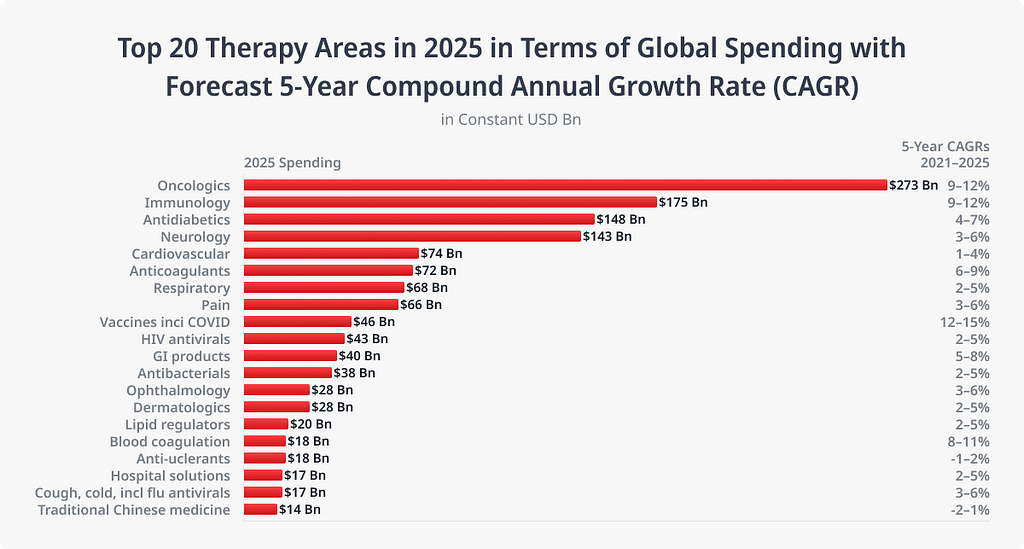
Global medicine market prognosis by IQVIA, 2021
The sooner customers get these medicines, the less they will worry about the price of such medicines.
Offer gifts for regular purchases, set up a reminder system that it’s time to buy medicines, offer free doctor or online pharmacist consultations to regular customers.
Bottom line
Ready to open an online pharmacy and organize all workflows remotely? The Simtech Development team will help with developing your website from scratch based on best eCommerce practices, and turn all your ambitious ideas into reality. Feel free to contact our team for a consultation.

